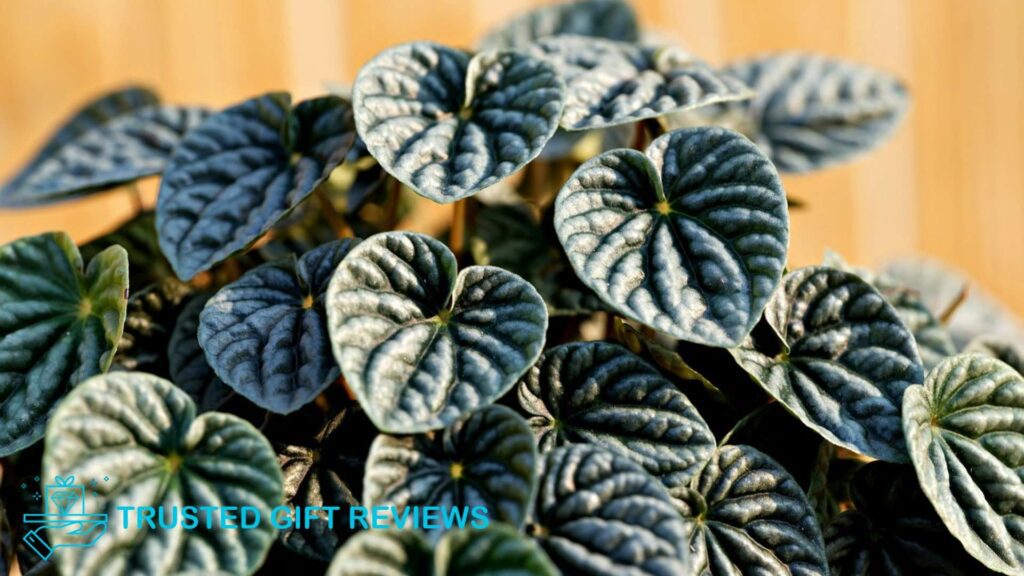Aside from having unique and attractive foliage, watermelon peperomias have a low-maintenance nature that makes them a favorite plant of many plant growers.
However, just because they are easy to care for doesn’t mean you don’t have to learn about their needs. Like many other houseplants, they also have specific care requirements that you need to understand if you want a thriving watermelon peperomia.
In this guide, we’ll teach you everything you need to know about these beautiful plants. We’ll reveal everything, from their lighting and watering requirements to the propagation methods you can follow.
Watermelon Peperomia General Information


Botanical Name: Pilea argyreia
Common Name: Watermelon peperomia, watermelon begonia
Genus: Peperomia
Family: Piperaceae
Origin: South America
Plant Type: Perennial plant
Plant Hardiness: USDA Zones 10 – 11
Growing Season: Spring and summer
Growth Rate: Slow to moderate grower
Mature Size: 6 to 12 inches tall
Toxicity: Non-toxic to humans and pets
Watermelon peperomias are perennial plants from the Piperaceae family. They are native to the forests of South America, but they can now be seen growing in most parts of the world, as they’ve become a popular houseplant choice.
They are best known for their beautiful leaves that resemble the rinds of watermelon, hence their common name. They produce flowers in upright stalks, which are small and easy to miss.
Watermelon peperomias are non-toxic to humans and pets, so they’re the ideal plant for families with pets and children. They’re also easy to care for, making them great plants for novice growers and busy individuals.
Taking Care of a Watermelon Peperomia
What soil is best for watermelon peperomia?


The best soil for watermelon peperomia is a well-draining potting mix that’s lightweight, aerated, and slightly acidic. The mix should also be able to retain a sufficient amount of moisture for healthy root growth.
Avoid buying succulent or cactus soil mixes since they can’t retain enough moisture for watermelon peperomia. If you only have succulent soil, amend it by adding more peat moss or coco coir to improve moisture retention.
Apart from succulent soil mixes, you can use any commercial houseplant mix in the market. Just check the pH occasionally to ensure it’s still within the 6 to 6.6 range.
How do I make my own soil mix for watermelon peperomia?


To create a good soil mix for your watermelon peperomia, you can try mixing these two recipes:
Recipe #1
- 1 part perlite
- 1 part vermicompost
- 1 part coco coir
Recipe #2
- ⅓ potting soil
- ⅓ vermiculite
- ⅓ coco coir
Both of these incorporate key elements of a good soil mix for watermelon peperomia: good drainage, aeration, and moisture retention. Perlite and vermiculite enhance drainage, while vermicompost and coco coir are responsible for moisture retention.
The first recipe is more appropriate for dry and warmer regions since it retains more moisture. In contrast, the second one is a better choice for those with a relatively humid environment.
How often should I water my watermelon peperomia?


Watermelon peperomia should be watered when the top inch of its soil feels dry, which typically translates to once every 1 to 2 weeks during spring and summer and every 3 to 5 weeks during winter.
This schedule isn’t absolute, and you should always check the soil first before watering. It’s better to err on the side of underwatering than overwatering since watermelon peperomias tend to be more tolerant of drying out between waterings.
The watering frequency of your plant will depend on specific conditions, such as light, temperature, and humidity levels. If you live in a tropical country with low humidity, you might need to water the plant more frequently.
Do watermelon peperomia require sun or shade?


Watermelon peperomia grow on tropical forest floors under the shade of tall trees. Hence, they’re more adapted to receive filtered or dappled sunlight, as the dense canopy of the forest scatters direct sunlight.
At home, watermelon peperomias should receive at least 5 hours of bright to medium indirect light. Their leaves may become scorched or damaged if exposed to direct sunlight, so it’s best to not place them near south-facing windows.
By providing bright to medium, indirect light, you’re replicating the lighting conditions watermelon peperomias are used to in the wild. This helps maintain the plant’s beautiful watermelon-like foliage.
What temperature is recommended for watermelon peperomia?


Watermelon peperomia thrives in average room temperatures that are comfortable for most people, making them great houseplant choices.
The recommended temperature range for watermelon peperomias is typically between 17°C to 27°C. However, they can tolerate slightly cooler temperatures during the night.
Avoid exposing them to temperatures below 10°C since they’re not cold-hardy, and this temperature can be fatal to them.
What humidity level is recommended for watermelon peperomia?


The ideal humidity for watermelon peperomia typically falls between 50% and 60%. The average humidity level in most homes falls within the same range, so maintaining a humidity level suitable for these plants won’t be that difficult.
During winter, the humidity can be too low due to heavier use of HVAC. Consider using a humidity tray or a room humidifier during this season to raise the humidity level around your watermelon peperomia.
Misting your watermelon peperomia every now and then can also help increase humidity around the plant.
How often should I fertilize my watermelon peperomia?
Watermelon peperomias are not heavy feeders, but fertilizing them every four to six weeks during summer and spring can be beneficial for them. During fall and winter, you can stop fertilization since they’re dormant.
Use a balanced, water-soluble, or liquid houseplant fertilizer during feeding because granular ones can be too strong. Dilute the fertilizer to half the recommended strength since full strength can be too much for watermelon peperomias to handle.
Always water your plant thoroughly for at least 24 hours before applying fertilizer to prepare the plant for fertilization. Your plant can suffer from root burn if you skip this step.
How often should I prune my watermelon peperomia?
Watermelon peperomias are not fast growers, so there’s no need for regular pruning. Only prune your plant when you feel like it has become crowded and leggy or when you see damaged leaves.
We recommend pruning them during spring and summer since they’re actively growing during these seasons. Don’t prune during winter since the plant is dormant then, and all its resources are directed to survival instead of growth.
Moreover, avoid heavy pruning, like cutting more than one-third of the plant at one time, as this can stress the plant.
When should I repot my watermelon peperomia?
Watermelon peperomias don’t require frequent repotting, but it’s a good idea to do so when they have outgrown their current container or the soil has become too compacted.
One of the common signs that your watermelon peperomia needs to be repotted is lack of growth. If the plant has become root-bound, the roots cannot absorb nutrients effectively, resulting in slower growth.
In general, watermelon peperomias must be repotted every 2 to 3 years. By this time, the nutrients in the potting mix have depleted, and adding more fertilizer won’t do much for the plant.
How to Repot My Watermelon Peperomia
Step 1: Prepare a bigger pot
Select a pot that’s about one size bigger than the current pot. This will give your watermelon peperomia more space to grow and encourage the roots to spread.
Step 2: Buy or make a new potting mix
When repotting your watermelon peperomia, you won’t be able to use the old potting mix since it can no longer provide the plant with the nutrients it needs.
Prepare a new mix similar to the one you used before to reduce the risk of transplant shock.
Step 3: Gently remove the watermelon peperomia from its old pot
Tap all the sides of the current pot to loosen up the soil. This can help you remove the plant from its current pot with minimal damage to the roots.
Step 4: Inspect the roots and trim the damaged parts
Shake off the old soil from the plant to get a better view of the root zone. Look for any signs of rot or damage and trim them with clean scissors.
If some roots have become too bound with each other, gently separate them to encourage better growth.
Step 5: Add an inch layer of the new potting mix to the pot
Adding an inch layer of the potting mix before placing the plant prevents the roots from touching the drainage holes. The roots may clog the drainage holes as they grow, so it’s good to place a barrier.
Step 6: Place the watermelon peperomia in the new pot
Position the watermelon peperomia in the center of the new pot and fill the sides with more potting mix. Gently press down the soil to settle the plant and stop it from moving around.
Step 7: Water the plant thoroughly
Once the plant is settled in its new pot, water it evenly and thoroughly. This can help reduce transplant shock, a common problem watermelon peperomia faces after repotting.
How to Successfully Propagate a Watermelon Peperomia
Propagating watermelon peperomia isn’t as hard as it sounds. In fact, it’s an easy task that you can do even as a novice plant grower.
Here are three different ways you can successfully propagate a watermelon peperomia:
Propagating Watermelon Peperomia Through Division
Step 1: Remove the plant from its pot
Gently remove the plant from its pot. If it doesn’t come out, try turning the pot upside down and tapping its sides and base to loosen up the soil inside.
Step 2: Trim unhealthy roots
Examine the root zone and remove unhealthy roots to make sure each section will only have healthy roots.
Step 3: Divide the roots into sections
Watermelon peperomias’ roots have natural divisions that you can follow to separate them into smaller sections. You can usually separate them by hand, but you can also use scissors to divide those that you can’t.
Step 4: Plant each section into its own pot
Plant each section into its own pot, and take care of them like you would for a mature plant. Use the same potting mix you used with the parent plant to help the section adjust to its new environment.
Propagating Watermelon Peperomia Through Stem Cutting
Step 1: Cut a leaf stem
If you look at your watermelon peperomia, you’ll find a red petiole that connects the leaf to the stem. Cut about an inch or more of this petiole using clean scissors.
Step 2: Place the cutting into a glass of water
Fill a glass with water and place the leaf stem cutting you have. Ensure the leaf isn’t touching the water to prevent bacterial growth.
Step 3: Wait for new roots to emerge
Change the water daily to make sure the petiole produces healthy roots. After a few days or weeks, you’ll start seeing roots emerging from the petiole.
Step 4: Plant the cutting into a new pot
Once the roots are 2 inches or more, you can remove the petiole from the glass and plant it in a new pot.
Propagating Watermelon Peperomia Through Leaf Cutting
Step 1: Cut a portion of a leaf of your watermelon peperomia
Cut a large watermelon peperomia leaf in half using clean scissors. Make sure to cut the leaf horizontally for better results.
Step 2: Plant the cuttings into a new soil mix
The cut end of the leaf cuttings should be buried in the soil as you plant them in a new container. Plant as many cuttings as you can to increase the probability of successful propagation.
Step 3: Cover the container with a clear plastic bag
Once the cuttings are planted, cover the container with a plastic bag to keep the humidity level around the plant high. This will prevent the cuttings from drying out and dying.
Step 4: Wait for the leaf cutting to grow roots
The cuttings will only start growing roots after a few days, so wait until they’re settled before removing the plastic bag.
Common Problems with Watermelon Peperomia
Curling and Drooping Leaves
If your watermelon peperomia’s leaves are curling or drooping, it’s probably not receiving enough water or the environment is too dry.
When the watermelon peperomia is not receiving enough moisture, it will conserve the little moisture it has by curling its leaves. Soon, the leaves will start drooping due to lack of moisture.
How to Fix Curling and Drooping Leaves
The best way to deal with drooping and curling leaves is by providing the plant with enough water and moisture.
Check the soil every day to see if it needs watering. Whenever you water, make sure to water thoroughly until you can see water dripping from the drainage holes.
Additionally, avoid placing the plant near heating vents and radiators since they usually make the environment drier than usual. Instead, place your watermelon peperomia near a humidifier or tray of water.
Pest Infestation
While watermelon peperomias are generally resistant to pests, they can still be infested by insects like spider mites, fungus gnats, scales, and mealybugs.
Spider mites, mealybugs, and scales are all sap-sucking pests that can cause significant damage to the plant. They can weaken the plant’s stem, resulting in leaves drooping, curling, and wilting.
On the other hand, fungus gnats don’t usually cause harm to the plant. Their larvae are the ones that can be detrimental to the plant since they directly target the roots.
How to Fix Pest Infestation
You can remove the pests by physically removing them with a cotton swab soaked in rubbing alcohol. You can also apply insecticidal soap or neem oil on the plant to kill them.
For fungus gnats, sticky traps are more effective since they don’t stay in one area and fly around.
Once you remove all the pests, make sure to do regular inspections of your plant to prevent the same problem from happening again.
Yellowing Leaves
The main reason leaves turn yellow is overwatering. When the roots are always submerged in water, there’s a high chance that fungi will grow, leading to damaged roots.
Once the roots get damaged, they won’t be able to absorb nutrients, like nitrogen and iron, necessary to produce chlorophyll. This results in a lack of green color in the leaves.
Sometimes, yellowing can also be caused by too much exposure to direct sunlight. The plant gets stressed from the heat and the leaves get damaged, leading to yellow leaves.
How to Fix Yellowing Leaves
To deal with yellowing leaves, adjust your watering routine to your plant’s needs. Don’t water it unless the upper part of the soil is dry to prevent overwatering.
If more leaves turn yellow even after adjusting your watering routine, the soil might not be draining enough. Consider repotting the plant to a more well-draining mix.
If your plant is placed near a window, move it somewhere with a bit of shade to help it recover.




